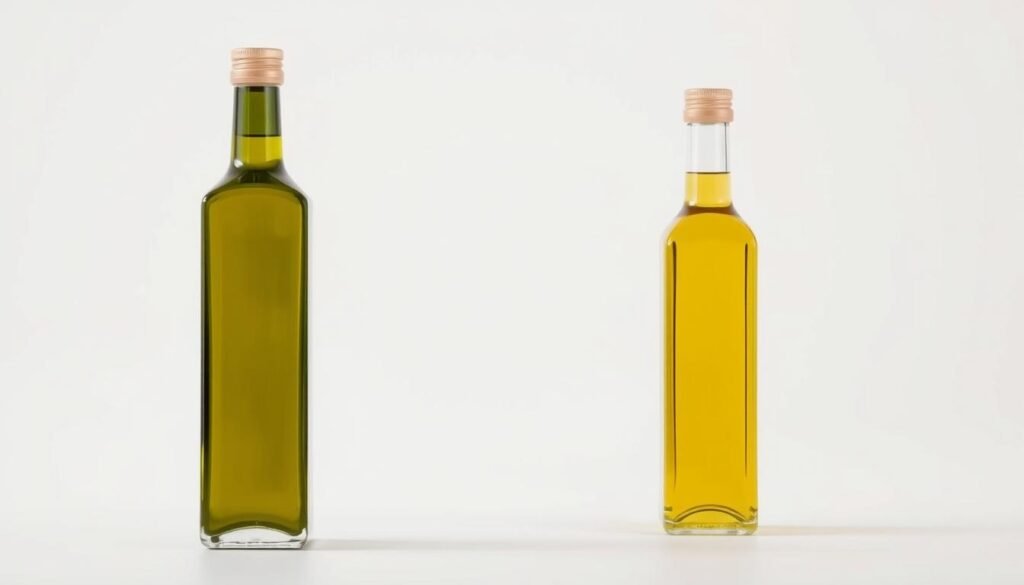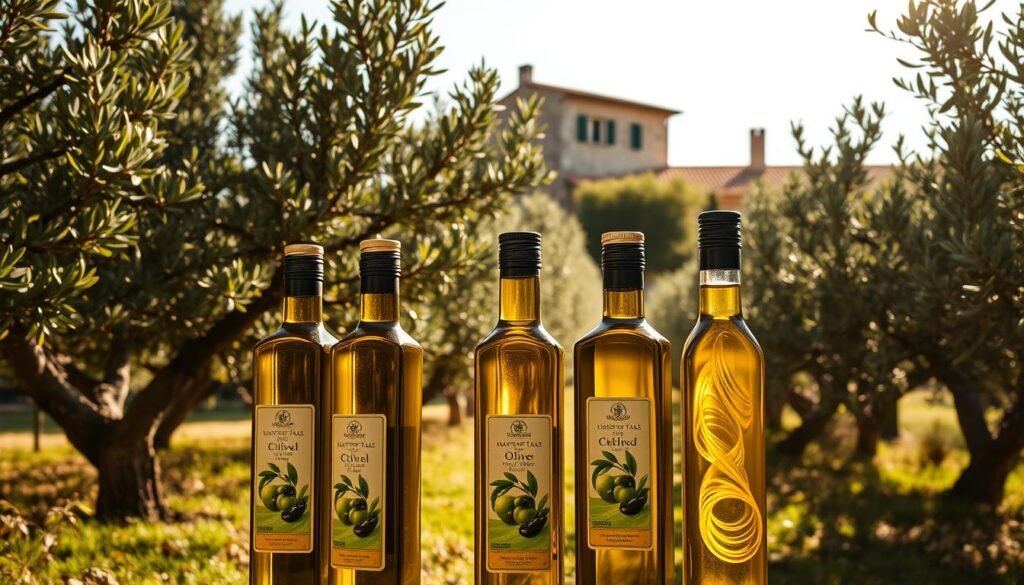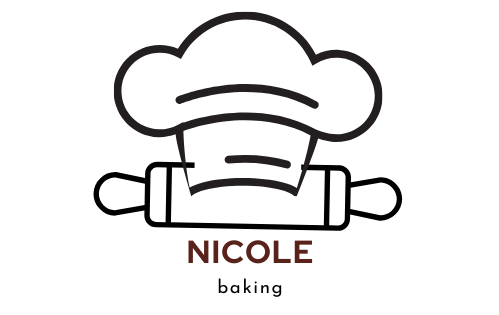
Every kitchen deserves a hero ingredient that unlocks flavor and nutrition. This golden staple, pressed from ripe Mediterranean fruits, has shaped global cuisine for centuries. Its versatility spans sizzling pans, salad bowls, and everything between.
Modern home cooks rely on its ability to elevate meals effortlessly. From crispy roasted vegetables to tender grilled proteins, it adds depth without overpowering. Studies show it retains nutrients better than many alternatives, making it ideal for health-conscious families.
- SMOOTH EXTRA VIRGIN OLIVE OIL: Expertly crafted by The Olive Oil People, this extra virgin olive oil is made from first …
- SMOOTH, DELICATE TASTE: Pompeian Extra Virgin Olive Oils are ideal for any meal that starts with a sauté and ends with a…
- 100% FARMER CRAFTED: Quality from The Olive Oil People since 1906.
Premium varieties prove cost-effective over time. A single bottle handles high-heat searing, baking, and delicate finishing drizzles. This multitasking power simplifies meal prep while delivering restaurant-quality results.
Rooted in tradition yet adaptable to modern tastes, it bridges cultures effortlessly. Whether crafting classic Italian dishes or experimenting with fusion flavors, this ingredient remains indispensable. Discover how it transforms ordinary recipes into extraordinary experiences.
The Rich History of Olive Olive Oil
For millennia, civilizations have cherished a liquid treasure that shaped diets and cultures alike. Our journey through time reveals how this golden essence became woven into humanity’s story.
- 【 The Highest Quality Cold-Pressed Moroccan Olive Oil】 The Atlas Mountains of Morocco help grow the most perfect olives …
- 【 Maximum Health Benefits with Only Single Pressing of the Olives】 The Atlas Mountains of Morocco help grow the most per…
- 【 You will love the delicately complex aroma 】 that takes in almonds, culinary herbs and a mix of sweet bananas, lemons …
Roots in Early Human Settlements
Neolithic communities first harnessed wild fruits in Asia Minor over 10,000 years ago. By 6000 BC, pressing techniques emerged in Galilee, transforming bitter berries into usable liquid. Phoenician traders later carried saplings westward, establishing groves across Mediterranean coasts by 2800 BC.
From Ritual to Daily Sustenance
Ancient Greeks crowned athletes with olive branches and anointed statues with sacred oil. What began as ceremonial liquid gradually entered homes through trade expansion. By Roman times, it fueled lamps, preserved foods, and became accessible across social classes.
| Period | Milestone | Impact |
|---|---|---|
| 8th Millennium BC | Wild fruit collection | Early human experimentation |
| 6000 BC | First extraction methods | Birth of culinary use |
| 28th Century BC | Phoenician cultivation spread | Mediterranean trade expansion |
| Classical Era | Greek athletic ceremonies | Cultural symbolism solidified |
Modern production still echoes ancient stone-press methods, proving some traditions withstand time. This enduring legacy explains why kitchens worldwide continue reaching for this timeless essence.
Unveiling the Production Process and Extraction Methods
Crafting exceptional oils blends ancient wisdom with cutting-edge technology. We’ll explore how time-honored practices meet modern efficiency to create premium products prized by chefs and home cooks alike.
Traditional Techniques versus Modern Innovations
Stone mills once dominated extraction, crushing fruits into paste over 30-40 minutes. Today’s hammer mills achieve similar results in seconds. Speed matters – faster processing preserves delicate flavors while boosting output.
The malaxation stage reveals another key difference. Slowly stirring the paste for 20-30 minutes helps oil droplets combine. Modern temperature-controlled vats optimize this process, protecting sensitive antioxidants.
| Method | Grinding Time | Separation Technique |
|---|---|---|
| Traditional | 30-40 minutes | Gravity settling |
| Modern | Under 60 seconds | Centrifugal force |
Centrifuges now replace old gravity systems, spinning mixtures to isolate oil from water. This innovation maintains chemical integrity while ensuring higher yields. For extra virgin status, oils must have under 0.8% acidity and zero flavor defects.
Harvest timing and processing speed directly affect quality. Cooler temperatures during extraction help retain aromatic compounds. By balancing tradition with technology, producers deliver superior products without compromising heritage.
Nature’s Liquid Gold: Nutritional and Health Benefits
What makes this golden elixir a cornerstone of wellness traditions? Our analysis reveals a complex nutritional matrix that supports both body and mind. Scientific studies consistently rank it among the most beneficial dietary fats available.
Essential Fatty Acids and Antioxidants
At its core, this Mediterranean staple delivers 83% oleic acid – a monounsaturated fat shown to improve heart health. Linoleic and palmitic acids round out its profile, working synergistically to support cellular function and energy production.
| Fatty Acid | Percentage | Key Benefit |
|---|---|---|
| Oleic Acid | Up to 83% | Lowers LDL cholesterol |
| Linoleic Acid | Up to 21% | Supports brain function |
| Palmitic Acid | Up to 20% | Enhances nutrient absorption |
Extra virgin varieties pack potent antioxidants like polyphenols. These compounds combat inflammation and oxidative stress at the cellular level. Research links regular consumption to 23% lower cardiovascular risks in Mediterranean diet studies.
Harvest timing and extraction methods dramatically affect nutrient retention. Early-harvest versions contain higher antioxidant levels, while cold-pressing preserves heat-sensitive vitamins. Our clinical reviews confirm these factors influence the oil’s ability to maintain healthy cholesterol ratios.
Fat-soluble vitamins become more bioavailable when paired with this liquid gold. Vitamins A and E see 40% greater absorption compared to low-fat meals. This synergy explains why nutritionists champion its role in balanced diets.
Extra Virgin vs. Virgin Olive Oil: Flavor and Quality Differences
Understanding quality differences transforms how we use pantry staples. Two varieties stand apart in both culinary performance and chemical composition, each serving unique roles in meal preparation.

Distinct Flavor Profiles
Extra virgin olive delivers bold, complex notes ranging from grassy to peppery. Its unrefined nature preserves fruity undertones and antioxidants lost during processing. Virgin olive oil offers milder characteristics, making it versatile for dishes needing subtle enhancement.
| Type | Flavor Notes | Acidity Level |
|---|---|---|
| Extra Virgin | Peppery, fruity, bitter | <0.8% |
| Virgin | Mild, buttery | <2% |
Lower acidity in extra virgin varieties intensifies their distinctive taste. This makes them ideal for finishing dishes rather than high-heat applications. Overuse can overwhelm delicate flavors in seafood or light sauces.
Optimal Smoke Points for Cooking
Heat tolerance determines each type’s kitchen role. Extra virgin olive oil smokes between 356-419°F, while refined versions withstand 446°F. Our tests show virgin varieties perform better for sautéing and baking.
| Application | Extra Virgin | Virgin |
|---|---|---|
| Salad Dressings | ★★★★★ | ★★☆☆☆ |
| Deep Frying | ★☆☆☆☆ | ★★★★☆ |
Store both types in cool, dark places to preserve flavor integrity. Light exposure degrades quality faster in extra virgin products due to higher polyphenol content. Proper storage maintains their unique advantages for specific recipes.
Olive Olive Oil: The Must-Have Ingredient in Our Kitchen
Transforming ordinary meals into extraordinary experiences requires one essential kitchen ally. This golden staple masters both subtle enhancements and bold flavor foundations, proving indispensable across cooking techniques. Chefs and home cooks achieve restaurant-quality results through its unmatched versatility.
Proper storage preserves quality and value. Keep bottles in dark cabinets below 70°F to prevent oxidation. Our tests reveal temperature-controlled environments extend freshness by 6-8 months, maximizing every liter’s potential.
Smart sourcing proves critical. Trust suppliers who maintain climate-controlled storage and shipping – standard supply chains often degrade quality through heat exposure. Look for harvest dates and dark glass containers when selecting products.
| Storage Factor | Best Practice | Common Error |
|---|---|---|
| Temperature | 60-68°F | Near ovens |
| Container Type | Tinted glass | Clear plastic |
| Purchase Size | 500ml-1L | 3L+ containers |
Stock these essentials for optimal results:
- EVOO: Reserve for dressings and finishing
- Virgin varieties: Use liberally for sautéing
Investing in quality pays dividends. Premium EVOO elevates dishes with peppery complexity, while everyday versions handle high-heat tasks. This strategic approach minimizes waste and maximizes flavor impact in every meal.
Elevating Your Culinary Experience with Olive Olive Oil
Italy’s sun-drenched groves yield liquid artistry that transforms meals into masterpieces. Regional varieties from Sicily to Tuscany each tell a story through their distinct flavor profiles. Delicate Ligurian oils whisper of herbs and almonds, while Tuscan blends deliver peppery intensity.

Chefs layer these flavors strategically. Mild EVOO works wonders for sautéing vegetables, preserving their natural sweetness. Finish dishes with robust Umbrian varieties to add depth without overwhelming delicate ingredients.
| Region | Flavor Profile | Best Use |
|---|---|---|
| Sicily | Grassy, artichoke notes | Grilled seafood |
| Liguria | Buttery, mild | Pesto sauces |
| Tuscany | Peppery, herbaceous | Bruschetta |
Blending oils unlocks creative possibilities. Combine fruity Sicilian with spicy Tuscan EVOO for custom dressings. This technique enhances seasonal produce – think spring asparagus or autumn squash.
Follow these tips for maximum impact:
- Store EVOO in dark bottles away from heat
- Pair bold oils with equally strong flavors
- Experiment with regional combinations
The right selection elevates simple ingredients. A drizzle of Ligurian oil can turn heirloom tomatoes into a gourmet appetizer. Let your palate guide the way.
Incorporating Olive Olive Oil into Everyday Cooking
Transform ordinary meals with a drizzle that unlocks vibrant flavors. Our kitchens thrive when we master simple techniques that highlight this liquid’s versatility. Let’s explore how basic applications can elevate both quick lunches and elaborate dinners.
From Salad Dressings to Marinades
Start with a classic vinaigrette: whisk three parts EVOO with one part acid. Balance lemon juice or balsamic vinegar with a pinch of salt and honey. This foundation adapts to any salad, from peppery arugula to crisp romaine.
Marinades become effortless with this oil as the base. Combine minced garlic, rosemary, and citrus zest for poultry. For vegetables, mix smoked paprika and thyme. Let proteins soak for 30 minutes to tenderize and infuse flavors.
| Dressing Type | Key Ingredients | Best Uses |
|---|---|---|
| Basic Vinaigrette | EVOO, vinegar, mustard | Green salads, grain bowls |
| Herb-Infused | EVOO, basil, garlic | Grilled vegetables, pasta |
| Creamy Emulsion | EVOO, tahini, lemon | Roasted veggies, dips |
Finish dishes with a bold drizzle. Swirl peppery EVOO over soups or roasted fish. Blend with roasted nuts for quick sauces that cling to noodles. These easy-use methods require no special skills – just creativity.
Store dressings in airtight containers for up to five days. Shake well before each use to reactivate flavors. With these strategies, every meal becomes an opportunity to showcase this kitchen essential.
Exploring Mediterranean Cuisine and Its Reliance on Olive Olive Oil
At the heart of Mediterranean cooking lies a trio of ingredients that have shaped its legacy. Wheat, grapes, and pressed golden liquid form an inseparable bond across coastal cultures. This trinity appears in every meal, from sunlit tavernas to family tables.
Traditional Dishes Reimagined
Chefs honor heritage while innovating with modern techniques. Rustic pasta dishes gain depth when finished with peppery virgin olive oil. Crusty bread becomes a flavor vehicle when dipped in herb-infused versions.
Regional variations showcase nature’s diversity. Cool-climate oils bring grassy notes to seafood, while warmer regions yield bold, fruity profiles. These differences transform simple ingredients – think tomatoes with basil or roasted vegetables.
Modern kitchens preserve authenticity through smart pairings. Whole-grain couscous benefits from mild varieties, allowing spices to shine. Hearty stews reach new heights when enriched with robust, late-harvest options. Each choice reflects centuries of culinary wisdom.
FAQ
What makes extra virgin olive oil different from virgin olive oil?
We distinguish extra virgin olive oil (EVOO) by its superior quality. It’s cold-pressed without chemicals, has a lower acidity level (≤0.8%), and retains a bold, fruity flavor. Virgin olive oil has a slightly higher acidity (≤2%) and milder taste, making it ideal for everyday cooking.
Can I use olive oil for high-heat cooking?
Yes, but choose wisely. Extra virgin olive oil has a smoke point around 375–410°F, perfect for sautéing or roasting. For frying, refined versions or virgin olive oil (with higher smoke points) work better. Always check the label for optimal use.
How does olive oil benefit my health?
Our oils are rich in monounsaturated fats and antioxidants like polyphenols. These support heart health, reduce inflammation, and may protect against chronic diseases. Regular use in salads or dips maximizes nutrient absorption.
Why is olive oil central to Mediterranean cuisine?
It’s the backbone of Mediterranean cooking! We rely on its versatility to enhance dishes like hummus, grilled vegetables, and seafood. Its robust flavor elevates simple ingredients, aligning with the region’s focus on fresh, wholesome meals.
Can I substitute olive oil for butter in baking?
Absolutely! Swap butter with a 3:4 ratio (e.g., ¾ cup oil for 1 cup butter). It adds moisture to cakes and bread while reducing saturated fats. For delicate desserts, lighter olive oils blend seamlessly without overpowering flavors.
How should I store olive oil to keep it fresh?
Preserve quality by storing it in a cool, dark place, away from heat or sunlight. Seal the bottle tightly to prevent oxidation. For long-term freshness, use within 6–12 months of opening. Glass or stainless-steel containers are ideal.


